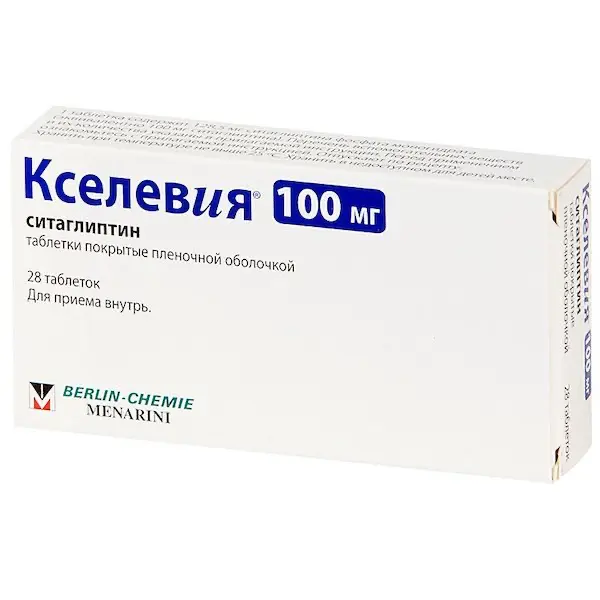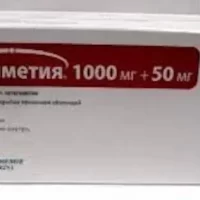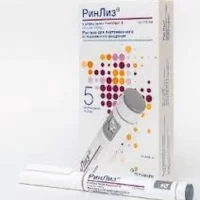Description
Xelevia Pharmacodynamics
Xelevia® (sitagliptin) is an active oral, highly selective inhibitor of dipeptidyl peptidase-4 (DPP-4) enzyme for the treatment of type 2 diabetes. Sitagliptin differs in its chemical structure and pharmacological action from glucagon-like peptide-1 (GFP-1) analogues, insulin, sulfonylurea derivatives, biguanides, gamma receptor agonists activated by peroxisome proliferator activated receptor (PPAR-?), alpha-glucosidase inhibitors, amylin analogues. By inhibiting DPP-4, sitagliptin increases the concentration of two hormones of the incretin family: GFP-1 and glucose-dependent insulinotropic polypeptide (GIP). Hormones of the hormone family are secreted in the intestine throughout the day and their concentration increases in response to food intake. Incretins are part of the internal physiological system of glucose homeostasis regulation. At normal or elevated blood glucose concentrations, hormones of the hincretin family help increase insulin synthesis as well as insulin secretion by beta cells of the pancreas through intracellular signaling mechanisms associated with cyclic adenosine monophosphate (AMP).
GFP-1 also contributes to the suppression of increased glucagon secretion by pancreatic alpha cells. A decrease in glucagon concentration against the background of an increase in insulin concentration contributes to a decrease in glucose production by the liver, resulting in a decrease in glycemia. This mechanism of action is different from that of sulfonylurea derivatives, which stimulate insulin release even at low blood glucose concentrations, which is fraught with the development of sulfone-induced hypoglycemia not only in type 2 diabetics, but also in healthy individuals.
At low blood glucose concentrations, the listed effects of the insectins on insulin release and decrease in glucagon secretion are not observed. GFP-1 and GIP have no effect on glucagon release in response to hypoglycemia. Under physiological conditions, the activity of incretins is limited by the enzyme DPP-4, which rapidly hydrolyzes the incretins to form inactive products.
Sitagliptin prevents hydrolysis of the hormones by DPP-4 enzyme, thereby increasing plasma concentrations of the active forms of GFP-1 and GIP. By increasing the concentration of encretins, sitagliptin increases glucose-dependent insulin release and helps to reduce glucagon secretion. In patients with hyperglycemic type 2 diabetes mellitus, these changes in insulin and glucagon secretion lead to a decrease in glycosylated hemoglobin HbA1C concentration and a decrease in plasma glucose concentration determined on an empty stomach and after a loading test.
In patients with type 2 diabetes, administration of one dose of Xelevia® causes inhibition of DPP-4 enzyme activity for 24 hours, which leads to 2-3 times increase of circulating concentration of insulin and C-peptide, decrease of plasma glucagon concentration, decrease of fasting glucose and also decrease of postprandial glucose or glucose load.
Indications
Monotherapy
Xelevia® is indicated as an adjunct to diet and exercise to improve glycemic control in patients with type 2 diabetes.
Combination therapy
Combination with metformin
Xelevia® in combination with metformin is indicated in patients with type 2 diabetes to improve glycemic control as starter therapy or when diet and exercise in combination with monotherapy with one of the listed drugs does not result in adequate glycemic control.
Combination with sulfonylurea derivatives
Xelevia® in combination with sulfonylurea derivatives is indicated for patients with type 2 diabetes mellitus to improve glycemic control when diet and exercise in combination with monotherapy with one of the listed drugs do not lead to adequate glycemic control.
Combination with PPAR-γ agonists
Xelevia® in combination with PPAR-γ agonists (thiazolidinediones) is indicated for patients with type 2 diabetes to improve glycemic control when diet and physical activity in combination with monotherapy with one of the listed drugs do not result in adequate glycemic control.
Combination with metformin and sulfonylurea derivatives
Xelevia® in combination with metformin and sulfonylurea derivatives is indicated for patients with type 2 diabetes to improve glycemic control when diet and exercise in combination with therapy with the two listed drugs do not result in adequate glycemic control.
Combination with metformin and PPAR-γ agonists
Xelevia® in combination with metformin and PPAR-γ agonists (thiazolidinediones) is indicated for patients with type 2 diabetes to improve glycemic control when diet and exercise in combination with therapy with the two listed drugs do not result in adequate glycemic control.
Combination with Insulin
Xelevia® is indicated for patients with type 2 diabetes as an adjunct to insulin (with or without metformin) when diet, exercise, and a stable dose of insulin do not result in adequate glycemic control.
Contraindications
– Hypersensitivity to any of the components of the drug;
– Pregnancy, breast-feeding;
– diabetes mellitus type 1;
– diabetic ketoacidosis;
– childhood under 18 years of age;
– moderate to severe renal failure (for this dosage – see section “Dosage and administration”).
Dosage and administration
- Recommended dose of Xelevia® is 100 mg 1 time per day as monotherapy or in combination with metformin or sulfonylurea derivatives or PPAR-γ agonists (thiazolidinedione) or insulin (with or without metformin) or in combination with metformin and sulfonylurea derivative or metformin and PPAR-γ agonists.
- Xelevia® may be taken regardless of meals. The dosing regimen of metformin, sulfonylurea derivatives, and PPAR-γ agonists should be based on the recommended doses of these drugs.
- When combining Xelevia® with sulfonylurea derivatives or with insulin, it is reasonable to reduce the traditionally recommended dose of sulfonylurea derivative or insulin to reduce the risk of sulfon-induced or insulin-induced hypoglycemia (see section “Cautionary Note: Hypoglycemia”).
- If the patient missed Xelevia® , the drug should be taken as soon as possible after the patient remembers about the missed drug intake.
- Double doses of Xelevia® should not be taken on the same day.
- Patients with renal insufficiency
- In patients with mild renal insufficiency (creatinine clearance (CK) ≥50 ml/min, which approximately corresponds to serum creatinine concentration ≤1.7 mg/dL in men and ≤1.5 mg/dL in women) Xelevia® dose adjustment is not required.
- Due to the necessity of sitagliptin dose adjustment in patients with moderate to severe renal insufficiency, Xelevia® is not indicated in this category of patients (absence of risk on 100 mg tablet and absence of 25 mg and 50 mg doses does not allow its dosage regimen in patients with moderate to severe renal insufficiency).
- Due to the need for dose adjustment in patients with renal insufficiency, it is recommended that renal function be assessed before starting treatment with sitagliptin and periodically during treatment.
- Patients with hepatic insufficiency
- No dose adjustment of Xelevia® is required in patients with mild to moderate hepatic impairment. The drug has not been studied in patients with severe hepatic impairment.





